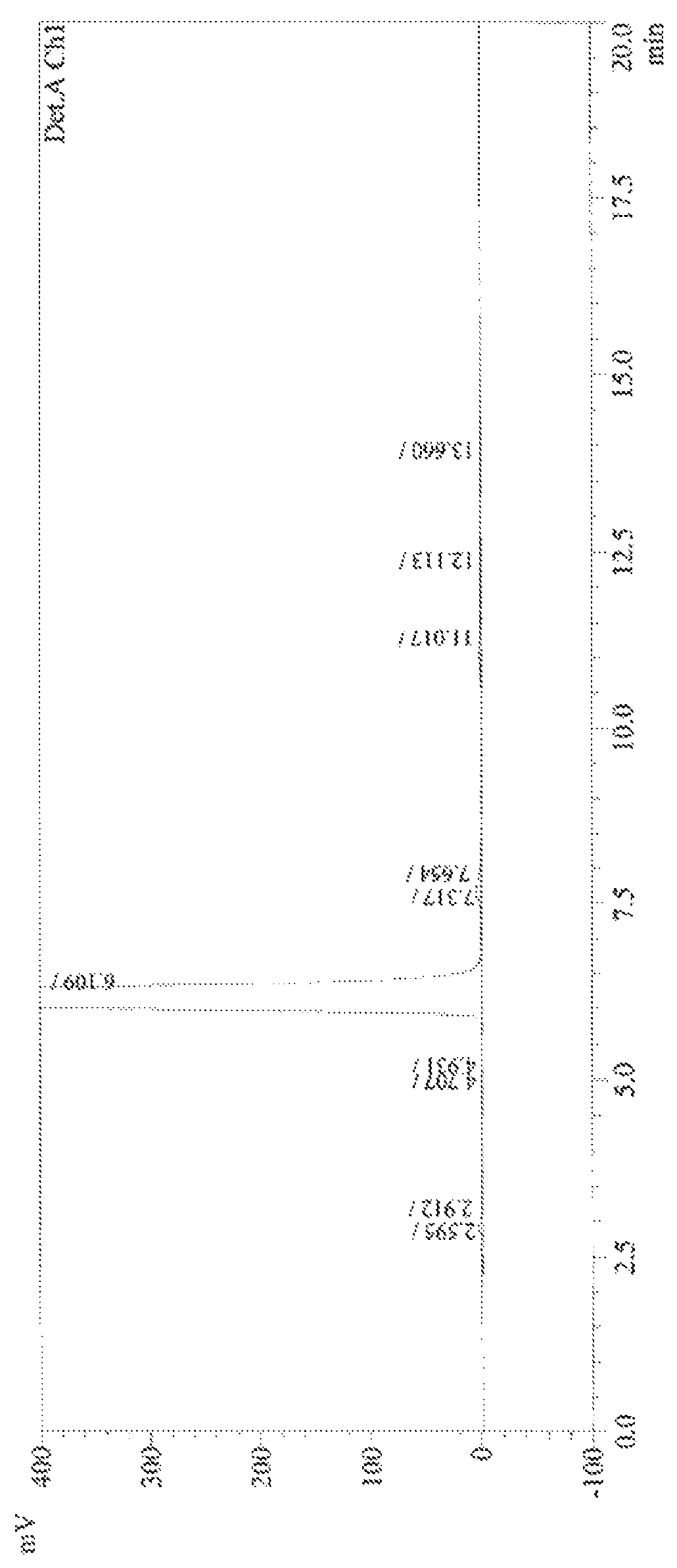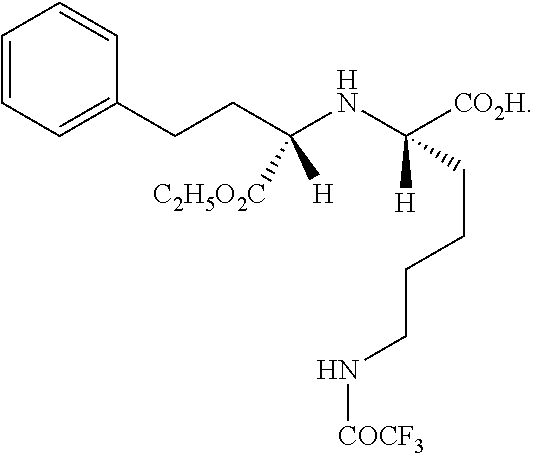Method for preparing lisinopril intermediate
a technology of lisinopril and intermediate, which is applied in the field of pharmaceutical and chemical industry, can solve the problems of costs, increasing the number of preparation steps, and easy production of impurities, and achieves short preparation routes, simple and convenient operation, and less impurities.
- Summary
- Abstract
- Description
- Claims
- Application Information
AI Technical Summary
Benefits of technology
Problems solved by technology
Method used
Image
Examples
example 1
[0045]20.8 g of (R)-ethyl 2-hydroxy-4-phenylbutyrate, 110 mL of dichloromethane and 42.4 g of sodium carbonate were added to a 250 mL three-necked flask, and 26.6 g of p-toluenesulfonyl chloride was slowly added at 0° C. The mixture was heated to 25° C. and reacted under stirring for 8 hours; the reaction solution was filtered, and 62.3 g of a tetramethylammonium salt of trifluoroacetyl lysine was added to the filtrate, and the obtained system reacted under stirring at 15° C. for 10 hours. The reaction solution was filtered, and the filtrate was distilled under reduced pressure to remove dichloromethane. 240 mL of n-hexane was added to the residue and the obtained system was stirred for 5 hours at 0-5° C., 37.2 g of product was obtained, it was determined by HPLC spectrogram that the product was N2-[1-(S)-ethoxycarbonyl-3-phenylpropyl]-N6-trifluoroacetyl-L-lysine, the yield was 86.0%, the HPLC purity was 98.6%, and the HPLC related data are shown in Table 1 below.
[0046]
TABLE 1PeakRe...
example 2
[0047]20.8 g of (R)-ethyl 2-hydroxy-4-phenylbutyrate, 150 mL of tetrahydrofuran and 20.2 g of triethylamine were added to a 250 mL three-necked flask, and 12.6 g of methylsulfonyl chloride was slowly added at 0° C. The mixture was heated to 25° C. and reacted under stirring for 8 hours; the reaction solution was filtered, and 37.2 g of a lithium salt of trifluoroacetyl lysine was added to the filtrate, and the obtained system reacted under stirring at 25° C. for 10 hours. The reaction solution was filtered, and the filtrate was distilled under reduced pressure to remove tetrahydrofuran. 85 mL of ethanol was added to the residue and the obtained system was stirred for 5 hours at 0° C., 35.9 g N2-[1-(S)-ethoxycarbonyl-3-phenylpropyl]-N6-trifluoroacetyl-L-lysine was obtained, the product showed a HPLC spectrogram that is the same as FIG. 1, the yield was 83.0%, the HPLC purity was 98.9%.
example 3
[0048]20.8 g of (R)-ethyl 2-hydroxy-4-phenylbutyrate, 150 mL of tetrahydrofuran and 19.8 g of pyridine were added to a 250 mL three-necked flask, and 13.5 g of methylsulfonyl chloride was slowly added at 0° C. The mixture was heated to 35° C. and reacted under stirring for 6 hours; the reaction solution was filtered, and 39.6 g of a sodium salt of trifluoroacetyl lysine was added to the filtrate, and the obtained system reacted under stirring at 25° C. for 10 hours. The reaction solution was filtered, and the filtrate was distilled under reduced pressure to remove tetrahydrofuran. 40 mL of n-hexane and 200 mL cyclohexane was added to the residue, the obtained system was stirred for 8 hours at 0° C., 36.6 g N2-[1-(S)-ethoxycarbonyl-3-phenylpropyl]-N6-trifluoroacetyl-L-lysine was obtained, the product showed a HPLC spectrogram that is the same as FIG. 1, the yield was 84.7%, the HPLC purity was 98.8%.
PUM
| Property | Measurement | Unit |
|---|---|---|
| temperature | aaaaa | aaaaa |
| temperature | aaaaa | aaaaa |
| molar ratio | aaaaa | aaaaa |
Abstract
Description
Claims
Application Information
 Login to View More
Login to View More - R&D
- Intellectual Property
- Life Sciences
- Materials
- Tech Scout
- Unparalleled Data Quality
- Higher Quality Content
- 60% Fewer Hallucinations
Browse by: Latest US Patents, China's latest patents, Technical Efficacy Thesaurus, Application Domain, Technology Topic, Popular Technical Reports.
© 2025 PatSnap. All rights reserved.Legal|Privacy policy|Modern Slavery Act Transparency Statement|Sitemap|About US| Contact US: help@patsnap.com



